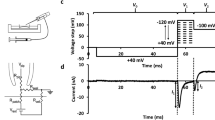Summary
Lobeline (0.05 to 2.5 mM) caused depolarization of muscle fibers in frog sartorius muscle bathed in chloride-free solution. When the extent of depolarization was plotted against the log of the concentration of lobeline, the relationship was described by a straight line with a slope of 57 mV for a 10-fold change in the concentration of lobeline (0.2 to 2.0 mM). Like lobeline, butacaine (0.1 to 0.5 mM) caused muscle depolarization with a 57 mV change in membrane potential for a 10-fold change in the concentration of the local anesthetic. Lobeline (0.05 to 0.15 mM) depressed the depolarization of the muscle fibers caused by the elevation of (K+]0 over a range of 2.5 to 50 mM. 42K-exchange in resting muscle was also depressed by lobeline (0.05 to 0.25 mM). The blockade by lobeline of 42K-efflux followed a typical dose-response relationship with 0.06 mM lobeline required to cause a 50% decrease of 42K-efflux. These findings show that lobeline in concentrations not much greater than those required to block neuromuscular transmission, has a direct action on ion exchange in skeletal muscle. These actions on electrogenic mechanisms may contribute to the anti-nicotinic action of lobeline and to the desensitization of endplate acetylcholine receptors caused by lobeline.
Similar content being viewed by others
References
Albuquerque, E. X., Barnard, E. C., Chiu, T. H., Lapa, A. J., Dolly, J. O., Jansson, S.-T., Daly, J., Witkop, B.: Acetylcholine receptor and ion conductance modulator sites at the murine neuromuscular junction: evidence from specific toxin reactions. Proc. nat. Acad. Sci. (Wash.) 70, 949–953 (1973)
Ariëns, E. J., Simonis, A. M.: Drug receptor interaction. Acta physiol. pharmacol. neerl. 11, 151–172 (1962)
Haefely, W.: The effects of various “nicotine-like” agents in the cat superior cervical ganglion in situ. Naunyn-Schmiedeberg's Arch. Pharmacol. 281, 93–117 (1974)
Hancock, J. C., Henderson, E. G.: Antinicotinic action of nicotine and lobeline on frog sartorius muscle. Naunyn-Schmiedeberg's Arch. Pharmacol. 272, 307–324 (1972)
Henderson, E. G., Volle, R. L.: Ion exchange in frog sartorius muscle treated with 9-aminoacridine or barium. J. Pharmacol. exp. Ther. 183, 356–369 (1972)
Henderson, E. G., Volle, R. L.: Asymmetrical blockade of potassium exchange in muscle by SKF 525-A: comparison with butacaine. J. Pharmacol. exp. Ther. 188, 553–563 (1974)
Hodgkin, A. L., Horowicz, P.: Movements of Na and K in single muscle fibers. J. Physiol. (Lond.) 145, 405–432 (1959)
Hodgkin, A. L., Katz, B.: The effect of sodium ions on the electrical activity of the giant axon of the squid. J. Physiol. (Lond.) 108, 37–77 (1949)
Hutter, O. F., Noble, D.: The chloride conductance of frog skeletal muscle. J. Physiol. (Lond.) 151, 89–102 (1960)
Jaramillo J, Volle R. L.: A comparison of the ganglionic stimulating and blocking properties of some nicotinic drugs. Arch. int. Pharmacolyn. 174, 88–97 (1968)
Katz, B., Thesleff, S.: A study of the “desensitization” produced by acetylcholine at the motor end-plate. J. Physiol. (Lond.) 138, 63–80 (1957)
Magazanik, L. G.: Mechanism of desensitization of postsynaptic membrane of muscle fiber (in Russian). Biofizika 13, 199–203 (1968)
Magazanik, L. G., Vyskocil, F.: Dependence of acetylcholine desensitization on the membrane potential of frog muscle fibre and on the ionic changes in the medium. J. Physiol. (Lond.) 210, 507–518 (1970)
Magazanik, L. G., Vyskocil, F.: The loci of α-bungarotoxin action on the muscle postjunctional membrane. Brain Res. 48 420–423 (1972)
Manthey, A. A.: The effect of calcium on the desensitization of membrane receptors at the neuromuscular junction. J. gen. Physiol. 49, 963–976 (1966)
Parsons, R. L.: Mechanism of neuromuscular blockade by tetraethylammonium. Amer. J. Physiol. 216, 925–931 (1969)
Sjodin, R. A.: Some cation interactions in muscle J. gen. Physiol. 44, 929–962 (1961)
Sjodin, R. A., Henderson, E. G.: Tracer and non-tracer potassium fluxes in frog sartorius muscle and the kinetics of net potassium movement. J. gen. Physiol. 47, 605–638 (1964)
Sperelakis, N., Schneider, M. F., Harris, E. J.: Decreased K+ conductance produced by Ba++ in frog sartorius fibers. J. gen. Physiol. 50, 1565–1583 (1967)
Steinberg, M. I., Volle, R. L.: A comparison of lobeline and nicotine at the frog neuromuscular junction. Naunyn-Schmiedeberg's Arch. Pharmacol. 272, 16–31 (1972)
Thesleff, S.: The mode of neuromuscular block caused by acetylcholine, nicotine, decamethonium and succinylcholine. Acta physiol. scand. 34, 218–231 (1955)
Volle, R. L.: Blockade by barium of potassium fluxes in frog sartorius muscle. Life Sci. 9, 175–180 (1970)
Volle, R. L.: Blockade by 9-aminoacridine of potassium fluxes in frog sartorius muscle. Biochem. Pharmacol. 20, 315–324 (1971)
Volle, R. L., Glisson, S. N., Henderson, E. G.: Blockade by tetraethylammonium (TEA) and rubidium of potassium exchange in sartorius muscle fibers: Distribution of 14C-TEA in muscle. Pflügers Arch. 333, 281–296 (1972)
Volle, R. L., Reynolds, L.: Receptor desensitization by lobeline and nicotine. Naunyn-Schmiedeberg's Arch. Pharmacol. 276, 49–54 (1973)
Vyskocil, F., Magazanik, L. G.: The desensitization of postjunctional muscle membrane after intracellular application of membrane stabilizers and snake venom polypeptides. Brain Res. 48, 417–419 (1972)
Author information
Authors and Affiliations
Additional information
This study was supported by a grant from AMA-ERF.
Rights and permissions
About this article
Cite this article
Volle, R.L. Blockade by lobeline of potassium exchange in skeletal muscle. Naunyn-Schmiedeberg's Arch. Pharmacol. 282, 335–347 (1974). https://doi.org/10.1007/BF00500983
Received:
Issue Date:
DOI: https://doi.org/10.1007/BF00500983



